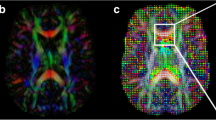Abstract
Purpose
To assess changes in apparent diffusion coefficient (ADC) and fractional anisotropy (FA) values in brainstem gliomas (BSG) in children and to observe the temporal evolution of changes in the white matter tracts following therapy using diffusion tensor imaging (DTI) analysis.
Methods
Serial ADC and FA measurements were obtained in three patients with newly diagnosed BSG on two approved treatment protocols. Values were compared with a set of normative ADC, FA, and eigenvalues of age-matched children of the corticospinal, transverse pontine and medial lemniscal tracts. Fiber tracking of the tracts coursing through the brainstem was performed using standard diffusion tractography analysis.
Results
We found increased ADC values within tumor at baseline compared to age-matched controls, with subsequent drop following treatment and subsequent increase with recurrence. Correspondingly, FA values were reduced at presentation, but transiently recovered during the phase of tumor response to treatment, and finally decreased significantly during tumor progression. These changes were concordant with the tractography analysis of white matter tracts in the brainstem. Based on these results, we suggest that initial changes in ADC and FA values reflects tract infiltration by tumor, but not complete disruption, whereas tumor progression results in complete loss of anisotropy possibly due to tract disruption.
Conclusion
Serial changes in ADC and FA values and tractography data in pediatric BSG suggest initial tumor infiltration, with transient improvement on treatment and subsequent loss of tract anisotropy during tumor progression. This technique may have potential use in assessing response to treatment regimens for pediatric BSG.









Similar content being viewed by others
References
Donaldson SS, Laningham F, Fisher PG (2006) Advances toward an understanding of brainstem gliomas. J Clin Oncol 24(8):1266–1272. doi:24/8/1266
Chan JL, Lee SW, Fraass BA, Normolle DP, Greenberg HS, Junck LR, Gebarski SS, Sandler HM (2002) Survival and failure patterns of high-grade gliomas after three-dimensional conformal radiotherapy. J Clin Oncol 20(6):1635–1642
Broniscer A, Gajjar A (2004) Supratentorial high-grade astrocytoma and diffuse brainstem glioma: two challenges for the pediatric oncologist. Oncologist 9(2):197–206
Albright AL, Packer RJ, Zimmerman R, Rorke LB, Boyett J, Hammond GD (1993) Magnetic resonance scans should replace biopsies for the diagnosis of diffuse brain stem gliomas: a report from the Children’s Cancer Group. Neurosurgery 33(6):1026–1029, discussion 1029–1030
Stieltjes B, Kaufmann WE, van Zijl PC, Fredericksen K, Pearlson GD, Solaiyappan M, Mori S (2001) Diffusion tensor imaging and axonal tracking in the human brainstem. Neuroimage 14(3):723–735. doi:10.1006/nimg.2001.0861
Field AS (2005) Diffusion tensor imaging at the crossroads: fiber tracking meets tissue characterization in brain tumors. AJNR Am J Neuroradiol 26(9):2168–2169. doi:26/9/2168
Holodny AI, Schwartz TH, Ollenschleger M, Liu WC, Schulder M (2001) Tumor involvement of the corticospinal tract: diffusion magnetic resonance tractography with intraoperative correlation. J Neurosurg 95(6):1082
Lu S, Ahn D, Johnson G, Cha S (2003) Peritumoral diffusion tensor imaging of high-grade gliomas and metastatic brain tumors. AJNR Am J Neuroradiol 24(5):937–941
Helton KJ, Phillips NS, Khan RB, Boop FA, Sanford RA, Zou P, Li CS, Langston JW, Ogg RJ (2006) Diffusion tensor imaging of tract involvement in children with pontine tumors. AJNR Am J Neuroradiol 27(4):786–793. doi:27/4/786
Helton KJ, Weeks JK, Phillips NS, Zou P, Kun LE, Khan RB, Gajjar A, Fouladi M, Broniscer A, Boop F, Li CS, Ogg RJ (2008) Diffusion tensor imaging of brainstem tumors: axonal degeneration of motor and sensory tracts. J Neurosurg Pediatr 1(4):270–276. doi:10.3171/PED/2008/1/4/270
Sorensen AG, Patel S, Harmath C, Bridges S, Synnott J, Sievers A, Yoon YH, Lee EJ, Yang MC, Lewis RF, Harris GJ, Lev M, Schaefer PW, Buchbinder BR, Barest G, Yamada K, Ponzo J, Kwon HY, Gemmete J, Farkas J, Tievsky AL, Ziegler RB, Salhus MR, Weisskoff R (2001) Comparison of diameter and perimeter methods for tumor volume calculation. J Clin Oncol 19(2):551–557
Evans AC (2006) The NIH MRI study of normal brain development. Neuroimage 30(1):184–202. doi:S1053-8119(05)00710-X
Jellison BJ, Field AS, Medow J, Lazar M, Salamat MS, Alexander AL (2004) Diffusion tensor imaging of cerebral white matter: a pictorial review of physics, fiber tract anatomy, and tumor imaging patterns. AJNR Am J Neuroradiol 25(3):356–369
Giussani C, Poliakov A, Ferri RT, Plawner LL, Browd SR, Shaw DW, Filardi TZ, Hoeppner C, Geyer JR, Olson JM, Douglas JG, Villavicencio EH, Ellenbogen RG, Ojemann JG DTI fiber tracking to differentiate demyelinating diseases from diffuse brain stem glioma. Neuroimage 52(1):217–223. doi:S1053-8119(10)00386-1
Phillips NS, Sanford RA, Helton KJ, Boop FA, Zou P, Tekautz T, Gajjar A, Ogg RJ (2005) Diffusion tensor imaging of intraaxial tumors at the cervicomedullary and pontomedullary junctions. Report of two cases. J Neurosurg 103(6 Suppl):557–562
Tropine A, Vucurevic G, Delani P, Boor S, Hopf N, Bohl J, Stoeter P (2004) Contribution of diffusion tensor imaging to delineation of gliomas and glioblastomas. J Magn Reson Imaging 20(6):905–912. doi:10.1002/jmri.20217
Witwer BP, Moftakhar R, Hasan KM, Deshmukh P, Haughton V, Field A, Arfanakis K, Noyes J, Moritz CH, Meyerand ME, Rowley HA, Alexander AL, Badie B (2002) Diffusion-tensor imaging of white matter tracts in patients with cerebral neoplasm. J Neurosurg 97(3):568–575. doi:10.3171/jns.2002.97.3.0568
Chen HJ, Panigrahy A, Dhall G, Finlay JL, Nelson Jr MD, Bluml S Apparent Diffusion and Fractional Anisotropy of Diffuse Intrinsic Brain Stem Gliomas. AJNR Am J Neuroradiol. doi:ajnr.A2179
Haas-Kogan DA, Banerjee A, Kocak M, Prados MD, Geyer JR, Fouladi M, McKnight T, Poussaint TY, Broniscer A, Blaney SM, Boyett JM, Kun LE (2008) Phase I trial of tipifarnib in children with newly diagnosed intrinsic diffuse brainstem glioma. Neuro Oncol 10(3):341–347. doi:15228517-2008-004
Acknowledgements
The authors acknowledge the support of the National Institute of Health (NIH) [U01 CA81457], the Pediatric Brain Tumor Consortium Foundation, the Pediatric Brain Tumor Foundation of the United States, and the American Lebanese–Syrian Associated Charities.
Conflicts of interest
The authors declare that they have no conflict of interest.
Author information
Authors and Affiliations
Corresponding author
Rights and permissions
About this article
Cite this article
Prabhu, S.P., Ng, S., Vajapeyam, S. et al. DTI assessment of the brainstem white matter tracts in pediatric BSG before and after therapy. Childs Nerv Syst 27, 11–18 (2011). https://doi.org/10.1007/s00381-010-1323-7
Received:
Accepted:
Published:
Issue Date:
DOI: https://doi.org/10.1007/s00381-010-1323-7




